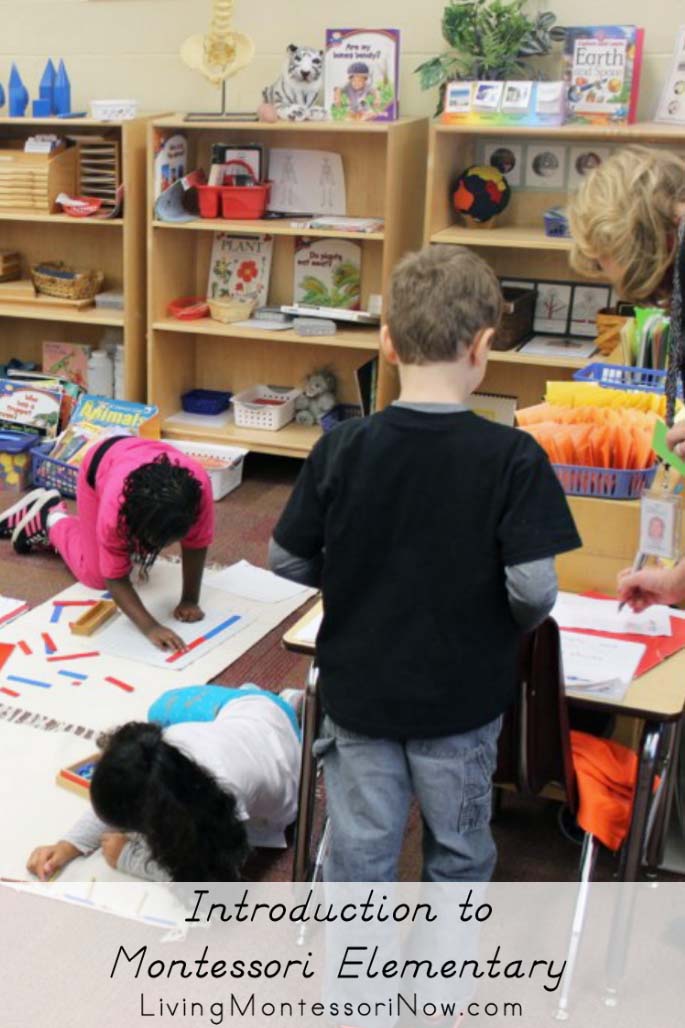As children reach elementary level, a common question Montessori homeschoolers and Montessori parents in general ask is some variation of “How long does my child need Montessori?”
If you’re thinking of the most important Montessori principle of following the child, I’d have to say that the answer to the question is “The rest of your child’s life.” By that, I simply mean that it’s important for a Montessori child to keep in mind his or her interests when making important decisions even as an adult. I still encourage my adult kids to follow their interests when making important life decisions. Of course, there will be times when sacrifices are necessary as an adult or when a temporary job won’t necessarily follow a person’s interests. But it’s still a good general rule to follow to help keep life on track.
If the question is related to using specific Montessori materials and lessons, the answer can vary dramatically from child to child. I love Montessori education at all levels, but it isn’t right (or possible) for every family or for every child past age five. As always, it’s important to observe your child to see what works best for him or her. And you have to consider what works for you and for the rest of your family, too.
If you’re asking if your child should continue attending a Montessori school past preschool (primary) level, check out this post from Montessori Daoshi: “The Season of Misgivings.”
For homeschoolers, the transition to Montessori elementary is difficult. It can be done, though, and there are a number of Montessori elementary homeschoolers online who’ll give inspiration and support. But if it feels too overwhelming to think of continuing Montessori homeschooling at the elementary level, don’t feel bad.
Montessori Influence for Life
Google Founder Larry Page attended Montessori until age 6, although co-founder Sergey Brin attended a Montessori school during grade school. Both Larry Page and Sergey Brin claim that Montessori was the key to their success. You can read more and see a video of them in my post “Anne Frank and Google Founders Share Montessori Link.”
My Montessori school in the 1980s only had children from ages 2½ -5. After that, all the students went on to traditional elementary schools, since there weren’t any Montessori elementary schools in my city. Here’s an email I received from Danielle, a student in my Montessori school during the 1980s, who found me online:
“I still remember so many things about your classroom, for instance learning how to tie my shoes, learning how to braid. I remember sitting on the oval and circle tapes of green and red. I learned how to read with you – and still love to. Thank you. Thank you for the impact and influence you have had on my life. It is still there, some almost 30 years after I first was exposed to the Montessori Method.”
Even Maria Montessori said:
“The most important period of life is not the age of university studies, but the first one, the period from birth to the age six; for that is the time when man’s intelligence itself, his greatest implement, is being formed.”
Different Approaches to Using Montessori in Homeschooling for Elementary and Beyond
My family homeschooled in the 1990s, so it was very difficult to find many affordable Montessori homeschool resources at the elementary level. We used unit studies and added some Montessori-inspired activities to our units. You can read a bit more about how we incorporated Montessori principles in my post “How to Be a Relaxed Homeschooler.”
Even though we didn’t use a lot of Montessori elementary materials, we still followed Montessori principles. For my children, that worked well. A Montessori elementary school would also have been wonderful for them. But it wasn’t essential. My children very much grew up as Montessori children.
Many Montessori homeschoolers go on to a modified use of Montessori when their child reaches elementary level. For example, some use Classical Conversations with added Montessori materials. Other Montessori homeschoolers tend to go toward a Charlotte Mason approach.
See my “Montessori Elementary Homeschool Inspiration and Ideas” for a variety of ways to incorporate Montessori into elementary homeschooling.
Montessori Elementary Resources
Here are my main Montessori elementary resource posts:
Introduction to Montessori Elementary (includes videos of Montessori elementary classrooms in action)
Montessori Elementary Homeschool Inspiration and Ideas
 Free Montessori Elementary Montessori Materials Online (including free Montessori elementary albums)
Free Montessori Elementary Montessori Materials Online (including free Montessori elementary albums)
 Where to Buy Montessori Elementary Albums and Materials
More Montessori Elementary posts.
Where to Buy Montessori Elementary Albums and Materials
More Montessori Elementary posts.
Wishing you the best as you choose the right approach or combination of approaches for your unique family and child. 🙂
If this is your first time visiting Living Montessori Now, welcome! If you haven’t already, please join us on our Living Montessori Now Facebook page where you’ll find a Free Printable of the Day and lots of inspiration and ideas for parenting and teaching! And please follow me on Instagram, Pinterest (lots of Montessori-, holiday-, and theme-related boards), and YouTube. While you’re here, please check out the Living Montessori Now shop.
And don’t forget one of the best ways to follow me by signing up for my weekly newsletter. You’ll receive some awesome freebies in the process!










I am sure many of your readers will find these resources extremely useful. I now regret that our daughter didn’t attend Montessori for her preschool years (she went to a play-based preschool). She is extremely advanced academically, but could use a lot of guidance in taking better care of her things! Thanks for sharing this post with Afterschool!
Thanks for your comment, Natalie! The sense of order and practical life skills (including social graces) kids gain are definitely some of my favorite results of Montessori education.